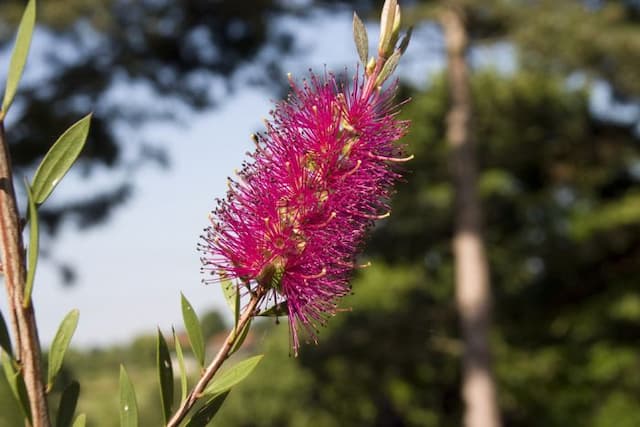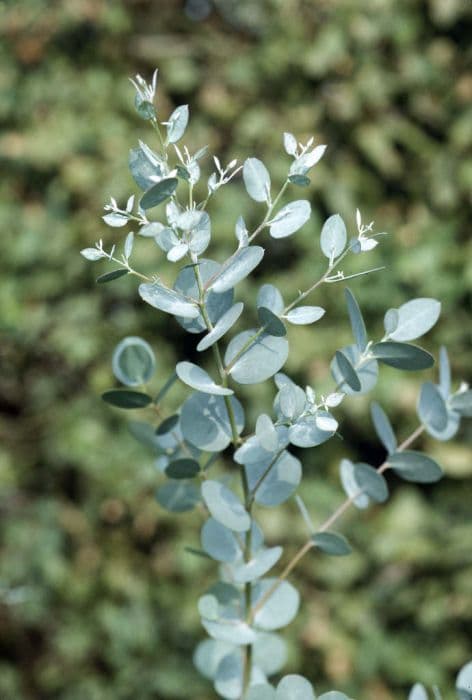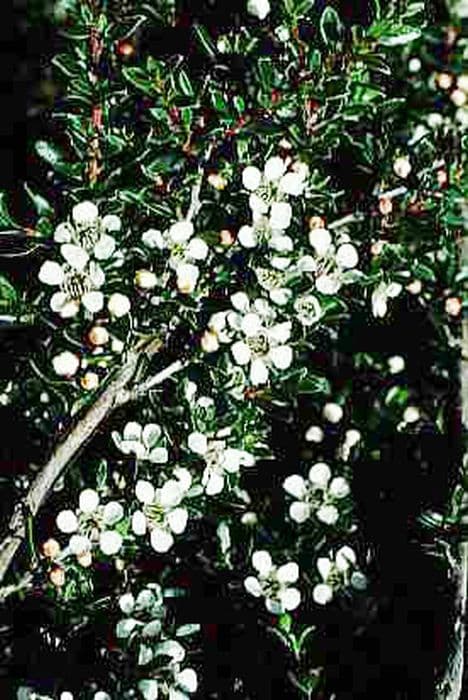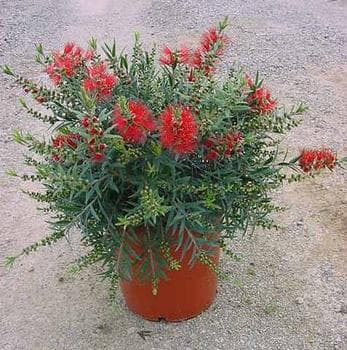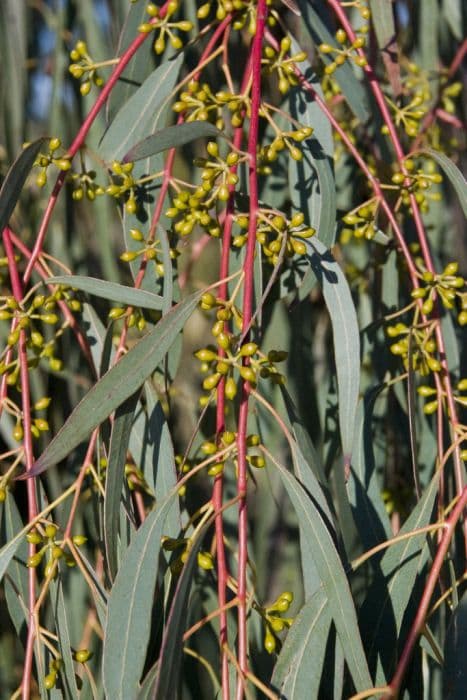Tasmanian alpine yellow gum Eucalyptus subcrenulata

ABOUT
E. subcrenulata is a tree to potentially 10-20m, with a moderately fast growth rate, but can be managed by pruning or coppicing. Bark is smooth and grey, with yellow-green patches, peeling when mature. Leaves are oval, glossy green and sometimes red-edged on juvenile growth, darker and more lanceolate on mature growth, aromatic
About this plant
 Names
NamesFamily
Myrtaceae
Synonyms
Alpine Yellow Gum, Tasmanian Alpine Yellow Gum, Yellow Gum
Common names
Eucalyptus subcrenulata.
 Characteristics
CharacteristicsLife cycle
Perennials
Foliage type
Evergreen
Color of leaves
Varies
Height
70 feet (21 meters)
Spread
25 feet (7.6 meters)
Plant type
Tree
Hardiness zones
9
Native area
Tasmania
Benefits
 General Benefits
General Benefits- Erosion Control: Eucalyptus subcrenulata, commonly known as Alpine Yellow Gum, has a robust root system that can help stabilize the soil and prevent erosion.
- Habitat for Wildlife: It provides food and shelter for various species of insects, birds, and small mammals.
- Ornamental Use: With its attractive bark and foliage, Alpine Yellow Gum is used for landscaping and ornamental purposes.
- Honey Production: The flowers of the Alpine Yellow Gum are a source of nectar for bees, aiding in honey production.
- Timber Production: The wood of this eucalyptus is valued for timber and pulp, important for the construction and paper industries.
- Shade and Shelter: Its canopy offers shade and shelter from the weather, being particularly useful in hot climates.
- Windbreaks: Planting Alpine Yellow Gum in rows can serve as effective windbreaks, protecting crops and soil from harsh winds.
 Medical Properties
Medical Properties- Antimicrobial: Eucalyptus subcrenulata contains compounds that may have antimicrobial effects, potentially helping to inhibit the growth of certain bacteria and fungi.
- Anti-inflammatory: It may possess anti-inflammatory properties which could help reduce inflammation in certain conditions.
- Expectorant: The plant may act as an expectorant, helping to clear mucus from the respiratory tract.
- Antiseptic: Eucalyptus subcrenulata may be used for its antiseptic qualities in treating minor wounds or infections.
 Air-purifying Qualities
Air-purifying QualitiesThis plant is not specifically known for air purifying qualities.
 Other Uses
Other Uses- Eucalyptus subcrenulata, commonly known as Alpine Yellow Gum, can be used as a source of nectar for bees, contributing to the production of a uniquely flavored honey.
- The wood of Alpine Yellow Gum is valued for woodworking and craft purposes due to its fine grain and workability.
- This plant's leaves can be used in the creation of dyes for fabrics, providing a range of natural colors depending on the mordant used.
- Alpine Yellow Gum can serve as a windbreak or shelterbelt tree, especially in rural and agricultural landscapes.
- The tree's fibrous bark is sometimes utilized in the creation of eco-friendly mulches for gardening and landscaping.
- Wood from Eucalyptus subcrenulata can be used as a renewable biofuel source for heating and electricity generation.
- The timber of Alpine Yellow Gum is also employed in making musical instruments, particularly woodwind instruments, because of its acoustic properties.
- In traditional papermaking, the pulp from Alpine Yellow Gum can be used to create high-quality paper products.
- The leaves of this eucalyptus can be included in potpourri mixes for natural home fragrancing.
- Alpine Yellow Gum can be planted for ornamental purposes, offering aesthetic appeal with its attractive bark and canopy.
Interesting Facts
 Feng Shui
Feng ShuiThe Alpine Yellow Gum is not used in Feng Shui practice.
 Zodiac Sign Compitability
Zodiac Sign CompitabilityThe Alpine Yellow Gum is not used in astrology practice.
 Plant Symbolism
Plant Symbolism- Healing: Eucalyptus subcrenulata, commonly known as Alpine Yellow Gum, often stands for healing because of its medicinal properties, especially in treating colds and respiratory issues.
- Protection: The plant is believed to offer protection, as Eucalyptus leaves are often used to cleanse spaces and ward off negativity in various cultural practices.
- Refreshing: Alpine Yellow Gum represents a refreshing energy due to its invigorating scent, which is thought to rejuvenate the mind and body.
- Purification: The plant symbolizes purification because it is commonly used in purification rituals and its oil has antiseptic qualities.
- Renewal: Much like its ability to regenerate after forest fires, the Alpine Yellow Gum is a symbol for renewal and the ability to bounce back from adversity.
 Water
WaterTasmanian Alpine Yellow Gum should be watered deeply and allowed to dry out partially between waterings. As a general guide, watering once a week with approximately 1-2 gallons of water should suffice. Adjust the frequency and amount based on temperature and humidity, watering more often during hot, dry periods, and reducing frequency during cooler, wetter months. Always check the top few inches of soil for moisture before watering to avoid overwatering.
 Light
LightTasmanian Alpine Yellow Gum thrives in full sunlight, ideally receiving at least 6 hours of direct sun exposure daily. The best spot for the plant is one where it will have unobstructed access to sunlight, away from taller structures or trees that might create significant shade.
 Temperature
TemperatureTasmanian Alpine Yellow Gum does well in a wide range of temperatures, but it prefers a moderate climate with temperatures ideally between 50°F and 80°F. It can tolerate cooler temperatures down to about 20°F and warmer temperatures up to approximately 90°F, but it may struggle outside of its ideal temperature range.
 Pruning
PruningTasmanian Alpine Yellow Gum benefits from pruning to maintain its shape, remove any dead or damaged branches, and promote healthy growth. Pruning should be done in the late winter or early spring before new growth starts. Prune lightly, targeting wayward branches, to preserve the plant's natural shape, generally once a year or as needed.
 Cleaning
CleaningAs needed
 Soil
SoilThe best soil mix for Tasmanian Alpine Yellow Gum (Eucalyptus subcrenulata) should be well-draining and consist of a combination of loam, sand, and peat moss to mimic its natural habitat conditions. A slightly acidic to neutral pH, ranging from 6.0 to 7.0, is ideal for this eucalyptus species.
 Repotting
RepottingTasmanian Alpine Yellow Gum should be repotted every 2 to 3 years or when it has outgrown its current pot. It's best to repot in the spring using the soil mix as described above and ensuring the new pot is one size larger than the old one.
 Humidity & Misting
Humidity & MistingTasmanian Alpine Yellow Gum prefers a moderate to high humidity level. While it can adapt to less humid conditions, maintaining a humidity level around 50-60% will best support its growth and health.
 Suitable locations
Suitable locationsIndoor
Ensure ample light, good airflow, and regular pruning for size.
Outdoor
Needs full sun, space to grow, and protection from frost.
 Life cycle
Life cycleEucalyptus subcrenulata, commonly known as Alpine Yellow Gum, begins its life as a seed, dispersing from the parent tree's capsules often after a triggering event such as a wildfire. Upon finding a suitable location in well-drained soil, the seed germinates and emerges as a seedling, with characteristic round, sessile juvenile leaves. As the seedling grows, it develops into a sapling with more elongated, stalked adult leaves that are glossy green. Through the juvenile and intermediate stages, the Alpine Yellow Gum continues to grow, its bark changing from smooth to a fibrous texture as it matures. The tree reaches reproductive maturity and starts flowering, usually from late spring to the middle of summer, producing white flowers that attract a range of pollinators. After pollination, seeds develop in woody capsules that can persist on the tree for several years, completing the lifecycle and beginning anew when these seeds are released.
 Propogation
PropogationPropogation time
Spring
The most popular method of propagation for Eucalyptus subcrenulata, commonly known as Alpine Yellow Gum, is through seed sowing. Optimal seed sowing time is usually in spring or early summer when temperatures are warm enough to facilitate germination. To propagate, seeds are typically sown in well-draining, sandy soil, just covered lightly with a fine layer of soil or sand, and kept moist until germination, which generally takes place within two to four weeks. Since Eucalyptus seeds are very small, they can be mixed with a fine dry sand to ensure an even distribution over the sowing surface. Once the seeds germinate and seedlings reach a sufficient size, they can be carefully transplanted to individual containers and later moved outdoors after the risk of frost has passed and they are strong enough to withstand outdoor conditions.
